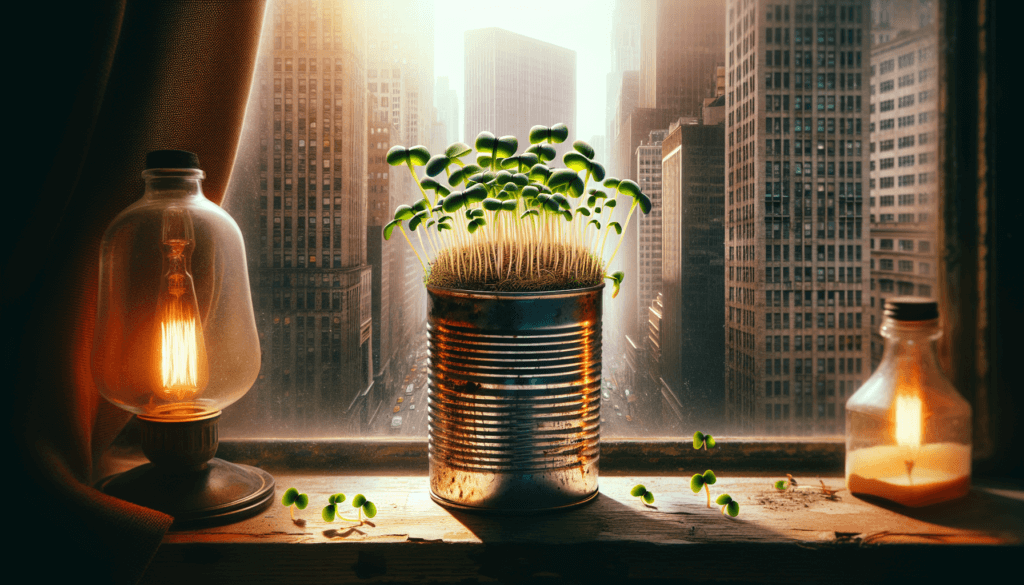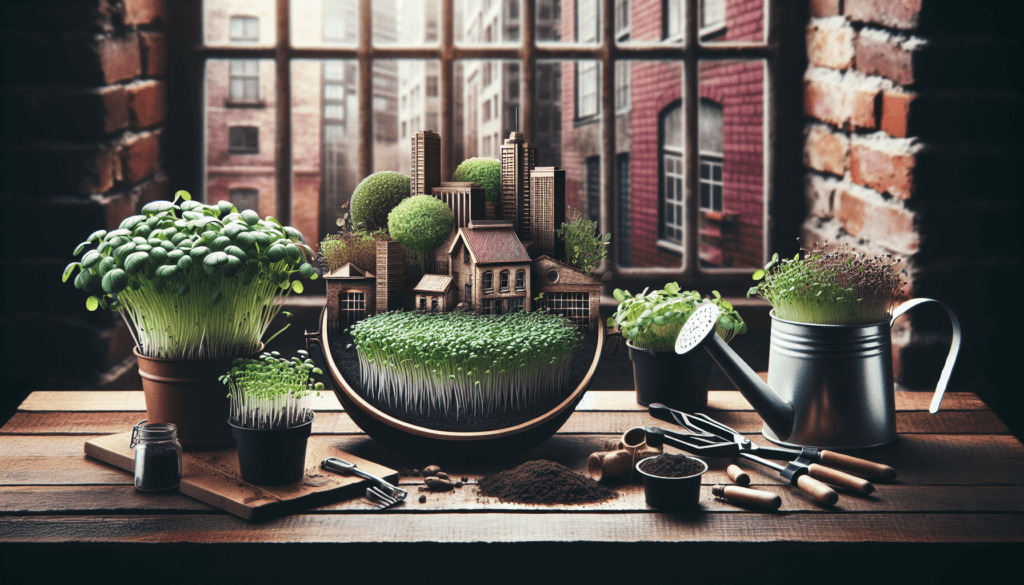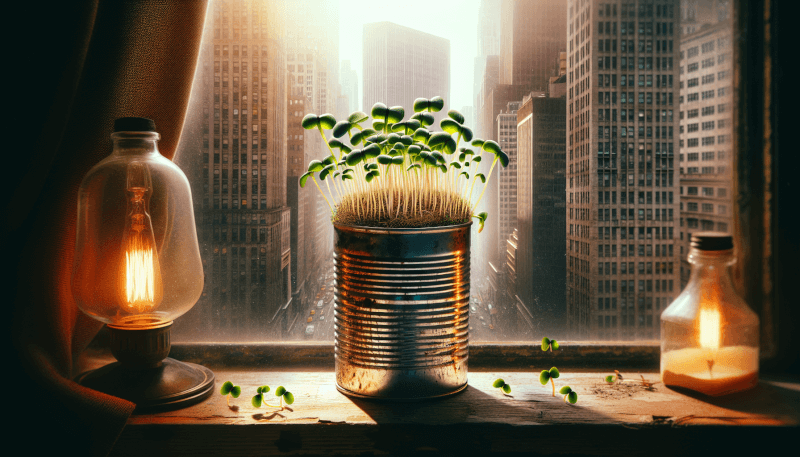Are you a city dweller with a green thumb? Well, we’ve got just the guide for you! “The Essential Guide To Growing Microgreens In The City” is here to help you discover the wonderful world of urban gardening. Whether you have a small balcony or a rooftop, this comprehensive guide will show you how to cultivate these nutrient-packed powerhouses right in the heart of the concrete jungle. From choosing the right seeds to nurturing your microgreens to harvest, this handy guide will turn any urban space into a thriving green oasis. So, grab your gardening gloves and get ready to transform your city living with the magic of microgreens!

Choosing the Right Microgreens
When it comes to growing microgreens, the first step is to choose the right varieties that match your preferences. Consider the flavors, textures, and colors that appeal to you. Are you looking for peppery greens like arugula or a delicate herb like basil? Take some time to research the various microgreen varieties available and make a list of the ones that pique your interest.
In addition to your preferences, it is important to assess the growing conditions you have available. Certain microgreens thrive in cooler temperatures, while others prefer warmer climates. Some microgreens require more sunlight, while others can tolerate lower light conditions. Take into account the temperature and lighting conditions in your indoor space to ensure you choose microgreens that will flourish in your environment.
Setting Up Your Indoor Growing Space
Selecting a suitable location is crucial for successful microgreen cultivation. Look for a spot with a good amount of natural light or be prepared to provide artificial lighting. Ensure that the location is well-ventilated and offers a stable temperature. Avoid areas that experience extreme temperature fluctuations or drafts.
Once you have chosen the location, it’s time to create your microgreens setup. Start by finding appropriate containers that are shallow and have good drainage. Plastic trays or shallow pots work well for microgreens. Next, consider the medium in which you will grow your microgreens. Many growers opt for soilless mediums like coco coir or peat moss, as they provide good moisture retention and prevent the risk of soil-borne diseases.
To provide proper lighting for your indoor cultivation, consider using grow lights. LED or fluorescent lights are popular choices for microgreen growers. Position the lights so that they are at an optimal distance from the microgreens, usually a few inches above the top of the trays. Remember to adjust the height of the lights as the microgreens grow to ensure they receive adequate light at all stages of growth.

Preparing the Growing Containers
Choosing appropriate containers for growing microgreens is essential for their development. As mentioned earlier, shallow trays or pots are ideal for microgreens. Look for containers that are at least two inches deep to allow room for root development. Additionally, the trays or pots should have drainage holes to prevent waterlogging.
Preparing the soil or growing medium is another crucial step in microgreen cultivation. If you choose to use soil, ensure that it is light, well-draining, and fertile. Optimize soil fertility by adding organic matter like compost or worm castings. If you prefer soilless mediums, moisten the coco coir or peat moss before spreading it evenly across the containers.
Proper drainage and airflow are vital for the health of your microgreens. Ensure that your containers have drainage holes to prevent water from pooling at the bottom. This will help avoid issues like root rot. Additionally, promoting airflow by placing a small fan near your setup can help prevent the development of mold or fungal diseases.
Sowing and Germinating Microgreens Seeds
Before sowing microgreen seeds, consider pre-soaking them to enhance germination. Soaking the seeds in water for a few hours or overnight can help speed up the germination process. Additionally, some growers choose to use a hydrogen peroxide solution during this step to further prevent the risk of disease.
When sowing the seeds, ensure that they are evenly distributed across the growing medium. Sprinkle the seeds over the soil or spread them out in a single layer. Lightly press the seeds into the growing medium to ensure good seed-to-soil contact.
To ensure optimal germination conditions, cover the trays or pots with a humidity dome or plastic wrap. This will create a mini greenhouse effect and help retain moisture. Keep the trays in a warm location with consistent temperatures for germination. Once the seeds have germinated, remove the cover and provide adequate airflow to prevent damping-off disease.

Caring for Your Microgreens
Watering and moisture control is an essential part of caring for your microgreens. Initially, mist the growing medium with water to ensure even moisture distribution. As the microgreens grow, water them gently with a spray bottle or use a watering can with a fine spout to prevent damaging the delicate greens. Avoid overwatering, as this can lead to mold or fungal growth. Aim to keep the growing medium consistently moist but not waterlogged.
Managing temperature and humidity is crucial for the successful growth of microgreens. Aim to maintain temperatures between 60 to 75 degrees Fahrenheit (15 to 24 degrees Celsius). High humidity can lead to mold or fungal growth, so ensure proper ventilation and airflow in your growing area to prevent these issues. Using a small fan for air circulation can help maintain optimal humidity levels.
Just like any other plants, microgreens require proper nutrition to thrive. Fertilizing is important to ensure healthy growth and development. Consider using a diluted liquid organic fertilizer or an organic seedling mix. Avoid over-fertilizing, as this can lead to nutrient burn. Follow the instructions on the fertilizer packaging and adjust accordingly based on the growth of your microgreens.
Managing Common Pests and Diseases
Identifying common pests is crucial for effective pest management. Common pests that can affect microgreens include aphids, fungus gnats, and spider mites. Regularly inspect your plants for any signs of pest activity, such as chewed leaves or tiny insects. Additionally, keep an eye out for any signs of disease, such as wilting or discoloration.
Implementing preventive measures is the first line of defense against pests and diseases. One effective method is practicing good sanitation by removing any dead or decaying plant material promptly. This helps prevent the buildup of pests and diseases. Additionally, consider using organic pest control methods like neem oil or introducing beneficial insects, such as ladybugs, to your growing space.
Natural methods for pest control can also be effective in managing pests. For example, companion planting can help repel certain pests or attract beneficial insects. Some common companion plants for microgreens include marigolds, nasturtiums, and dill. Additionally, regularly inspecting your microgreens and manually removing any pests can be an effective method of control.

Harvesting Microgreens
Determining the proper harvest time is essential to maximize the flavor and nutritional value of your microgreens. Most microgreens are ready to harvest when they have developed their first set of true leaves, which typically occurs around 10 to 14 days after sowing. However, some varieties may take longer or shorter periods to reach this stage. Pay close attention to the appearance and taste of the microgreens to determine their readiness.
Cutting and harvesting techniques can vary depending on the microgreen variety. Use clean, sharp scissors or a knife to cut the microgreens just above the soil level. Be gentle when handling them to avoid damaging the delicate leaves. If you plan to store the harvested microgreens, rinse them gently with water, pat them dry, and store them in airtight containers in the refrigerator.
Storing and preserving harvested microgreens is important to maintain their freshness and flavor. To prolong the shelf life of your microgreens, store them in airtight containers or plastic bags. Keep them refrigerated and try to consume them within a week for optimal freshness. Avoid washing the microgreens until you are ready to use them, as excess moisture can accelerate spoilage.
Exploring Flavorful Microgreen Varieties
Microgreens not only add visual appeal to dishes, but they also offer various nutritional benefits. Different microgreen varieties contain a wide range of vitamins, minerals, and antioxidants. For example, broccoli microgreens are high in sulforaphane, which is known for its anticancer properties. Radish microgreens are rich in vitamin C and can add a spicy kick to salads.
Popular microgreens for culinary use include sunflower, pea shoots, cilantro, and red amaranth. These varieties offer unique flavors that can enhance the taste of sandwiches, salads, and stir-fries. Experiment with mixing and matching different microgreens to create unique flavor combinations and add a fresh twist to your meals.

Recycling and Composting in Urban Microgreen Gardening
Managing organic waste sustainably is an important aspect of urban microgreen gardening. Instead of throwing away leftover microgreen scraps or unused growing medium, consider composting them. Composting not only helps reduce waste but also produces nutrient-rich compost that can be used to enrich your soil for future gardening endeavors.
Composting methods for indoor gardening can be adapted to suit the limited space available in urban environments. Consider using a small compost bin or vermicomposting system, which utilizes worms to break down organic matter. Ensure that the compost bin or system is well-maintained, with proper ventilation and moisture control. This will help promote the decomposition process and prevent unpleasant odors.
Using compost to enrich soil is an excellent way to improve its fertility and structure. Mix the compost into existing soil or use it as a top dressing when starting new crops. Compost adds essential nutrients, improves water retention, and enhances microbial activity in the soil. This results in healthier, more productive plants and a more sustainable gardening practice.
Exploring Creative Uses of Microgreens
Microgreens have become increasingly popular not only for their culinary uses but also for their decorative and creative applications. Incorporating microgreens into various recipes and meals can add a vibrant burst of color and flavor. Use them as a garnish for soups, sprinkle them on top of pizzas, or incorporate them into sandwiches and wraps for an extra layer of freshness.
In addition to culinary uses, microgreens can also be utilized in skincare products. Their antioxidant-rich properties make them beneficial for creating homemade facial masks, scrubs, and creams. Consider blending microgreens with other natural ingredients like honey or yogurt to create a nourishing and revitalizing skincare treatment.
Microgreens also make beautiful and eye-catching decorations. Arrange them in small pots or trays and place them around your home or office for a touch of greenery. Microgreens can also be used to create living centerpieces for special occasions or as table decor during gatherings. Get creative and explore different ways to incorporate microgreens into your everyday life.
In conclusion, growing microgreens in an urban environment is an accessible and rewarding endeavor. By choosing the right microgreen varieties, setting up your indoor growing space correctly, and providing proper care, you can enjoy a bountiful harvest of nutrient-rich greens. Take the time to experiment with different flavors, explore creative uses, and embrace the sustainable practices of recycling and composting. With a little effort and enthusiasm, you can enjoy the fresh, vibrant flavors of microgreens right in your own home. Happy growing!


